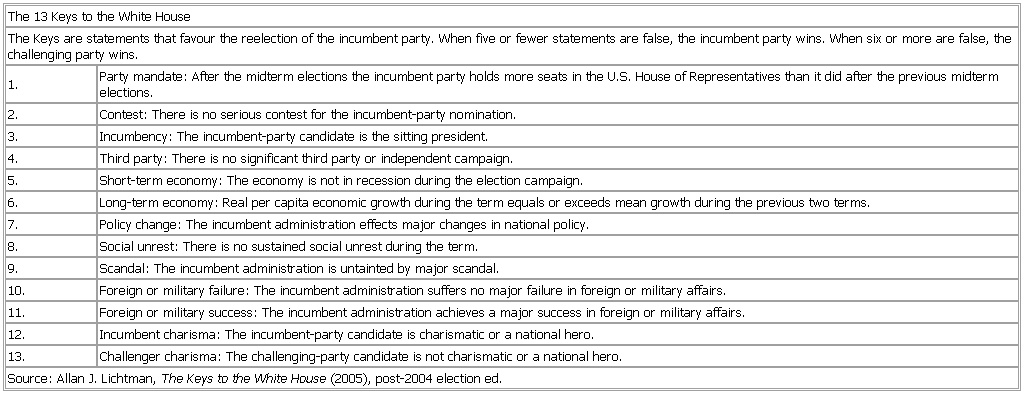13 Keys to the White House
Table
The 13 Keys to the White House
The Keys are statements that favour the reelection of the incumbent party. When five or fewer statements are false, the incumbent party wins. When six or more are false, the challenging party wins.
1. Party mandate: After the midterm elections the incumbent party holds more seats in the U.S. House of Representatives than it did after the previous midterm elections.
2. Contest: There is no serious contest for the incumbent-party nomination.
3. Incumbency: The incumbent-party candidate is the sitting president.
4. Third party: There is no significant third party or independent campaign.
5. Short-term economy: The economy is not in recession during the election campaign.
6. Long-term economy: Real per capita economic growth during the term equals or exceeds mean growth during the previous two terms.
7. Policy change: The incumbent administration effects major changes in national policy.
8. Social unrest: There is no sustained social unrest during the term.
9. Scandal: The incumbent administration is untainted by major scandal.
10. Foreign or military failure: The incumbent administration suffers no major failure in foreign or military affairs.
11. Foreign or military success: The incumbent administration achieves a major success in foreign or military affairs.
12. Incumbent charisma: The incumbent-party candidate is charismatic or a national hero.
13. Challenger charisma: The challenging-party candidate is not charismatic or a national hero.
Source: Allan J. Lichtman, The Keys to the White House (2005), post-2004 election ed.
See as table:

- Munda, Battle of
- Munda languages
- Munday, Anthony
- Mundelein
- Mundelein, George William
- Mundell, Robert A.
- Mundurukú
- Mundy, John
- Mundy, William
- Munger
- Mungo
- Mungo Park
- munia
- Munich
- Munich agreement
- Munich, University of
- Municipal, and Boilermakers' Union General
- Municipal General, and Boilermakers' Union
- municipality
- municipio
- municipium
- Muni, Paul
- Munkar and Nakīr
- Munk, Kaj
- Munn v. Illinois